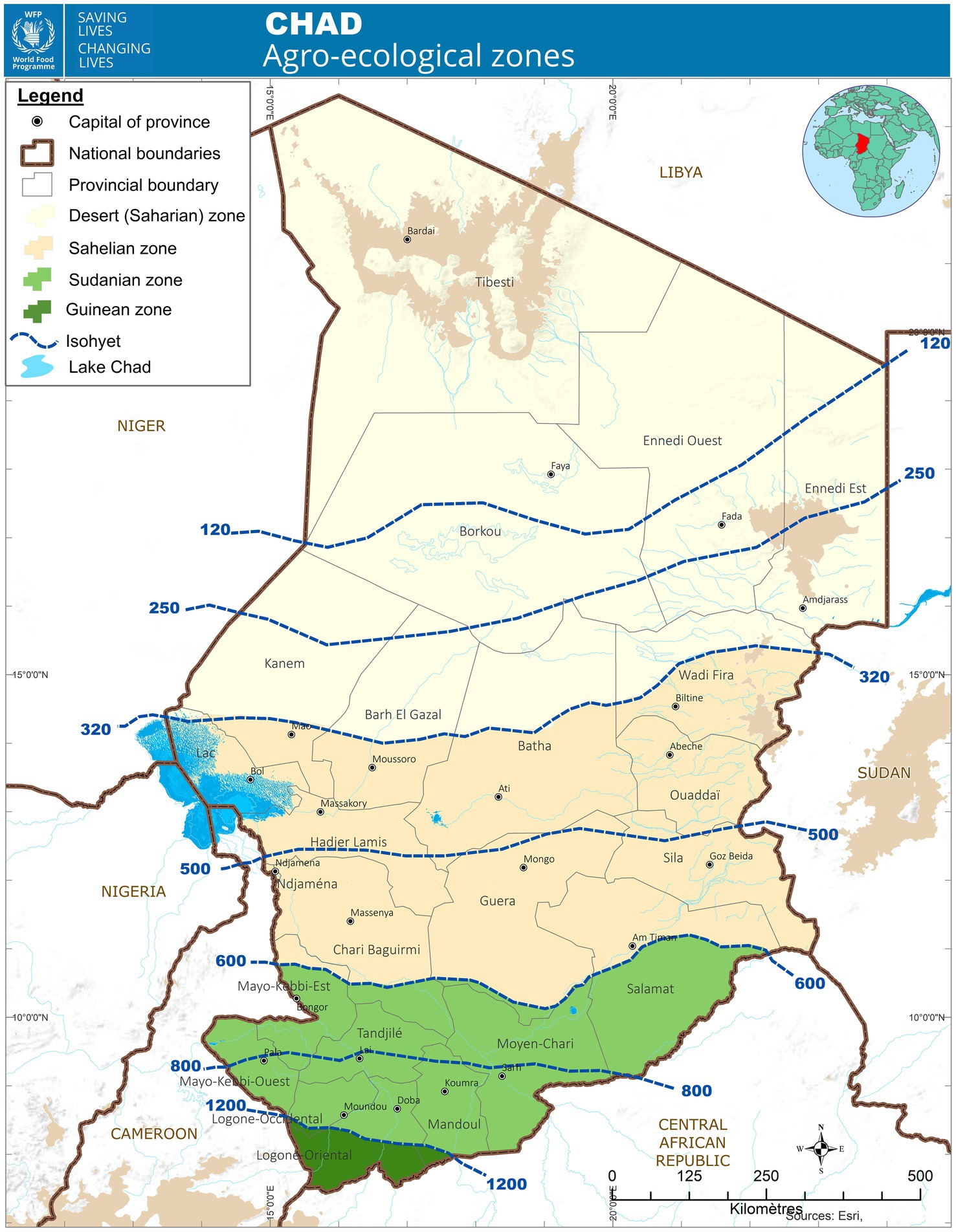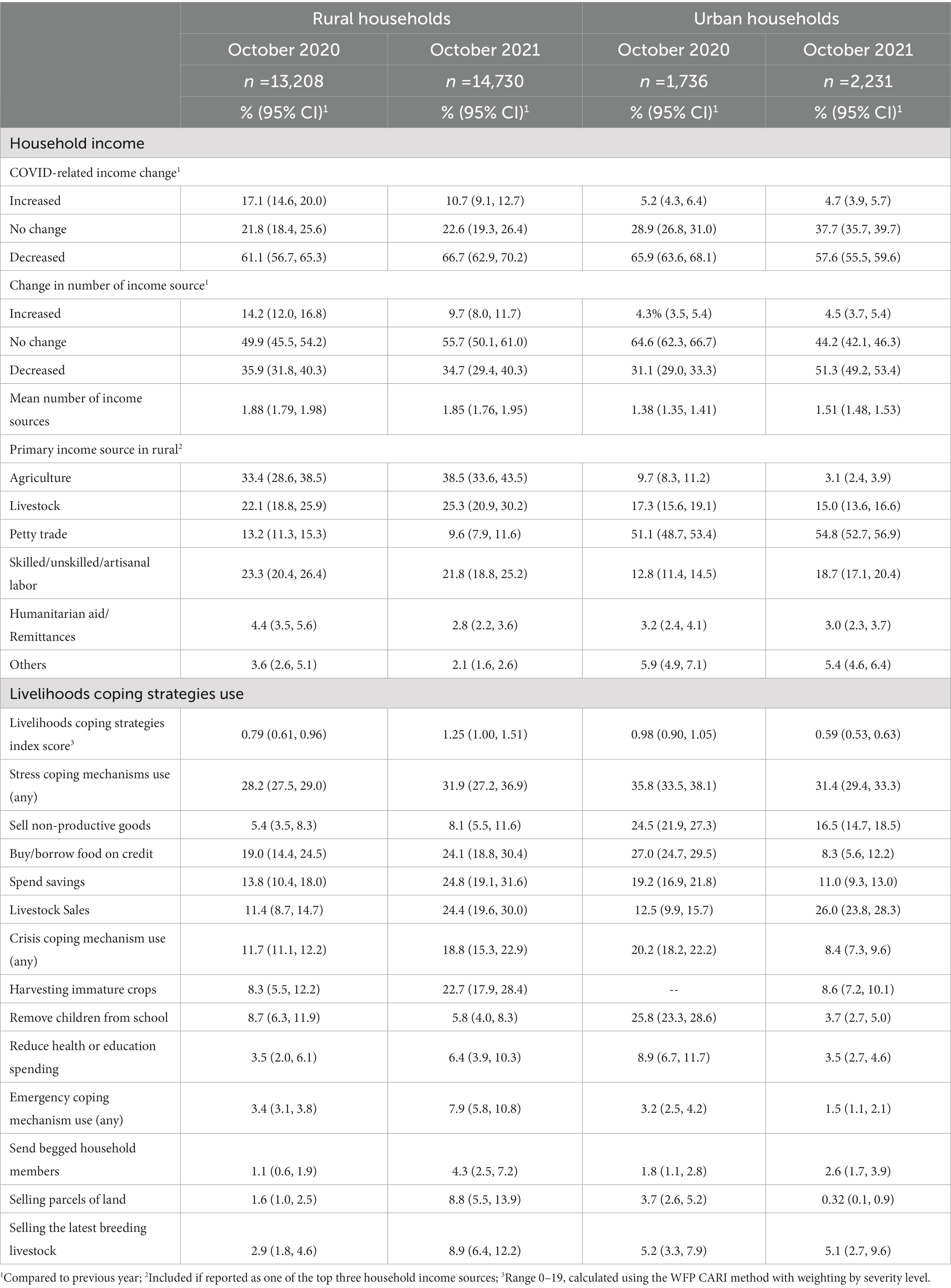- 1Department of International Health, Johns Hopkins Bloomberg School of Public Health, Baltimore, MD, United States
- 2World Food Programme Chad—N’Djamena, N’Djamena, Chad
Introduction: Impacts of the economic slowdown due to COVID-19 were prevalent in SubSaharan African countries. Using four nationally representative surveys collected in 2020 (rural n = 13,208; urban n = 1736) and 2021 (n = 14,730; n = 2,231), this secondary analysis evaluates economic impacts of the pandemic on household income and use of livelihoods-related coping mechanisms in Chad.
Methods: Univariate and multivariate regression, accounting for the survey design and sampling weights, was used to examine risk factors for reported income reduction and coping mechanism use and the associations with food expenditures and food security.
Results: The economic impact of COVID-19 was greater in urban areas than rural areas in 2020 with improvement in urban areas and deterioration in rural areas in 2021. The reported income reduction was associated with female and unmarried household heads, living in the Saharan zone, and in rural areas, non-agricultural income sources. In urban areas, having skilled/unskilled labor as the primary income source was protective. Risk factors for the adoption of livelihoods-related coping mechanisms were similar to those of income reduction, with findings related to poor living conditions. Income reduction due to COVID-19 was associated with the use of stress and crisis coping strategies and lower household expenditure in both years and poor food consumption in rural areas in 2020.
Discussion: This study elucidates the potential impact pathways of COVID-19 from a household economic downturn to limited food spending, poor food consumption, and increased use of coping mechanisms. Findings are relevant for informing the targeting of assistance in future economic shocks and suggest prioritizing socioeconomically vulnerable households.
1. Introduction
There has been a marked decline in global food security triggered by recent COVID-19-related lockdowns and supply chain disruptions that led to decreases in household income and purchasing power in many countries (Workie et al., 2020; Béné et al., 2021). This situation has led to a surge in the global malnourished population. Around 2.3 billion people were moderately or severely food insecure in 2021, and 11.7% percent of the global population faced severe food insecurity (FAO, IFAD, UNICEF, WFP, and WHO, 2022). According to the Food and Agriculture Organization of the United Nations (FAO), after increasing sharply in 2020, the global prevalence of moderate or severe food insecurity remained mostly unchanged in 2021, but severe food insecurity rose higher, reflecting a deteriorating situation for people already facing serious hardships (FAO, IFAD, UNICEF, WFP, and WHO, 2022).
Differential vulnerability linked to COVID-19 disruptions was more apparent in lower- and middle-income countries (LMICs) where impoverished populations have less access to social safety net programs and were more likely to be food insecure at the onset of the pandemic than in high-income countries (Arndt et al., 2020; Buheji et al., 2020; Chirisa et al., 2022). For example, urban populations were more likely to lose employment and have reduced income than the rural population in the Asia Pacific region, and low-income households faced elevated risk of economic loss than higher-income groups (Kang et al., 2021; Padmaja et al., 2022). Similarly, the reduction in food expenditures in 2020 was higher in urban areas in Bangladesh, India and Myanmar, suggesting that both household economic and food insecurity impacts of the pandemic were more extensive in urban areas than rural areas during the first year of the pandemic (Kang et al., 2021). In Sub-Saharan Africa, a multi-country study found that female-headed households, those having less-formal education and in lower economic groups were more vulnerable to food insecurity (Dasgupta and Robinson, 2021; Negesse et al., 2022). In 2020 only, women lost more than 64 million jobs disproportionally compared to men (80 million) (International Labor Organization, 2021). Largely, women have low wages and informal jobs, and were less likely to have institutional support (Shahidul and Mostafa, 2021). At a regional level in Sub-Saharan Africa, female-headed households were at higher risk of income loss due to a lack of control over financial and social-capital resources during the pandemic (Dasgupta and Robinson, 2021) and socio-economically disadvantaged groups have also been observed as more severely impacted (Burström and Tao, 2020; Macharia et al., 2021).
A landlocked Sahelian country in Africa, Chad is among the least developed countries, ranking 187 out of 189 on the Human Development Index in 2019. Although the country has made progress on poverty reduction, the population living below the poverty line increased from 4.7 million in 2011 to 6.5 million in 2018 (World Bank, 2022a). The first case of COVID-19 in Chad was detected on March 5, 2020 and 7,696 infections and 194 coronavirus-related deaths had been reported by Apr 19, 2023 (WHO, 2023). Following this onset, and in line with global trends and practices, Chad declared a health emergency and imposed a series of COVID-19 prevention measures throughout the rest of 2020 and 2021. These included the closure of borders and businesses, restricted movements between regions, and the implementation of curfews among others (Système d’Information sur la Sécurité Alimentaire et d’Alerte Précoce du TCHAD, 2022).
Similar to other Sahelian countries, the Government in Chad alongside humanitarian and development partners has fairly well-established systems to respond to the [recurrent] shocks and vulnerabilities that result from the confluence of structural poverty, conflict, climate change, and limited economic opportunities. However, there is a paucity of studies characterizing the economic impact of COVID-19 on food security and livelihoods in Chad (Mennechet and Dzomo, 2020; Tchana Tchana et al., 2022). In consequence, responses to such pandemic threats are not fully adapted to address the needs that arise. Since the likelihood of pandemics has increased over the past century and will likely continue or intensify (Patel et al., 2015), and given the variable impact of COVID-19 disruptions, this analysis sought to characterize changes in household economy during the onset of the COVID-19 pandemic among households in Chad to fill the existing knowledge gap.
The analysis used nationally representative household survey data to examine the economic impacts of COVID-19 among the population in Chad. Specifically, the study sought to identify risk factors for income loss due to COVID-19 and the use of crisis and emergency coping mechanisms; and to examine associations between income change due to COVID-19 and coping strategy use, short and long-term expenditures, and food consumption. Identifying population sub-groups that are particularly vulnerable to economic hardship and financial strain related to the indirect effects of the COVID-19 pandemic can inform humanitarian and development [policy]responses in future pandemics and contribute to a broader understanding of how economic disruptions differentially impact vulnerable populations in Chad and beyond.
2. Methods
The analysis is based on secondary datasets of the “Enquête Nationale sur la Sécurité Alimentaire” or National Food Security Assessments, hereafter referred to as ENSA. The ENSA survey is representative at the admin 2 (department) level and has been conducted annually since 2016 with nation-wide coverage (that is, conducted in all departments). The ENSA is organized by a specialized institution of the Government of Chad in partnership with WFP, FAO among other institutions. The full ENSA methodology is described elsewhere (Système d’Information sur la Sécurité Alimentaire et d’Alerte Précoce du TCHAD, 2020). However, in brief, a two-stage probabilistic cluster sampling methodology was used to select villages and households within each of the 68 departments [which served as strata] and N’Djamena. In 2020, data collection was conducted from October 17 to November 3, 2020, in rural areas and October 15 to November 27 in N’Djamena. Data collection spanned a similar period in 2021 and was conducted between October 3 and November 12 in rural areas, and October 7 to November 18 in N’Djamena. The total sample size was 13,208 households in 2020 and 14,730 households in 2021 in rural areas, while that in the urban (N’Djamena) surveys was 1,736 households in 2020 and 2,231 households in 2021.
The questionnaires covered a variety of topics such as sociodemographic characteristics, household assets, agricultural practices, sources of income, level of food stocks, food consumption, expenditures, household shocks, and coping mechanisms. Data from ENSA 2020 was considered ‘early COVID,’ and data from ENSA 2021 was considered ‘during COVID,’ with COVID questions included in both time sets. Key variables of focus for this analysis included perceived income change, use of livelihoods-related coping mechanisms, food consumption and household food expenditures. Income change due to COVID-19 was assessed as a categorical variable comparing the change in revenues in the preceding 3 months to the same period last year and was re-coded to a dichotomous variable (no change/increased vs. decreased) for analysis. Use of livelihoods-related coping mechanisms within the past month was collected using the Livelihoods Coping Strategies Index (LCSI) (WFP VAM resource center, 2021) and was categorized into three levels of severity: (1) stress coping mechanisms (non-productive asset sales, livestock sales, buying/borrowing food on credit and spending savings); (2) crisis coping mechanisms (harvesting immature crops, removing children from school, and reducing health and/or education spending); and (3) emergency coping mechanisms (sending household members for begging; selling the last breeding livestock and selling land). The LCSI was then calculated for each household using weighting by severity level and summing all coping mechanisms adopted. Food Consumption Score (FCS) is a standard indicator that reflects the diversity and frequency of household food consumption in the preceding week (Wiesmann et al., 2009); foods are categorized into eight groups, weighted according to nutritional value, and summed to calculate the FCS; households are then grouped into two food consumption group (poor/borderline vs. acceptable) based on pre-determined thresholds. Finally, household expenditure variables included household expenses in the short-term (preceding month) and long-term (6 months), and the proportion of food expenses of total household expenditures.
Using the October 2020 and 2021 ENSA datasets, this analysis sought to identify spatial–temporal trends and factors associated with the household economy and food security during COVID-19 separately in rural and urban areas. Statistical analysis was conducted using STATA/SE 17.0 (Stata Corporation, College Station, TX, United States). All analyses accounted for survey design and sampling weights. Point estimates and 95% confidence interval were generated for independent and dependent variables, and are presented for urban and rural locations, agro-ecological zones (Saharan, Sahelian, and Sudanian: Figure 1); and wealth quintiles, which were generated using propensity score analysis based on asset variables. Univariate logistic regression was conducted to test the association between each of the potential risk factors and outcome variables (income change due to COVID-19, crisis and emergency coping mechanism use), and if the value of p was <0.10 the variable was included in the multivariate logistic regression analysis. The variables that presented significance (p < 0.05 or 95%CI not including 1.0) were considered significant risk factors. Predictor characteristics to be tested for the association with outcome variables included socioeconomic characteristics (i.e., age, gender, marital status, literacy, occupation), household composition (i.e., size, disability, and chronic disease status of family members) and living conditions (i.e., dwelling type, water, energy and cooking source), and agroecological zone. Additionally, the association between change in income due to COVID-19 (no change/increased vs. decreased) and food security outcome variables such as coping strategy use, household expenditures, and food consumption were explored using income change due to COVID-19 as the independent variable. Dependent variables are the use of any stress and/or emergency coping mechanisms, short and long-term food expenditures, and food consumption (poor/borderline vs. acceptable). Linear regression was used to test the association between income due to COVID-19 and short and long-term food expenditures (continuous variables). Expenditure distributions were right-skewed, necessitating log-transformation. Demographic and socio-economic variables were accounted for in the adjusted regression analysis and included residence location (agroecological zone) and household characteristics. The association between household income change due to COVID-19 and expenditures was not tested in urban areas in 2021 due to a small sample size.
The study was determined to be exempt by the Johns Hopkins Bloomberg School of Public Health Institutional Review Board review because it involved secondary analysis of anonymized data.
3. Results
Analysis of ENSA data is presented separately for urban and rural areas for both October/November 2020 (early COVID period) and October/November 2021 (COVID period).
3.1. Household demographic characteristics
Household demographic characteristics are summarized in Table 1. The average household size was 7 in both N’Djamena and rural areas, and 39.4–44.2% of households were classified as large households, which were defined as ≥8 members. Polygamous households were more frequent in rural areas (26.7–28.7%) as compared to N’Djamena (15.2–16.9%), while N’Djamena households were more likely than rural households to be female-headed (38.7–39.4% vs. 17.9–21.9%, respectively). Household head illiteracy was more prevalent in rural areas (62.7–63.3%) than in N’Djamena (38.7–39.4%). Almost all households had no use of electricity as an energy source in rural areas (0.1–0.2%) and most residences were built with brick and cement, with a higher percentage in N’Djamena. There were notable differences in the use of efficient cooking sources between urban areas (76.9–85.1%) and rural areas (0.2%); similarly, access to improved drinking water was higher in N’Djamena (≥99.7) as compared to rural areas (54.7–58.2%). In rural areas, nearly half of the sample came from Sahelian and Sudanian zone, whereas respondents from Saharan zone accounted for only 3.4 and 6.0% of the 2020 and 2021 samples, respectively.
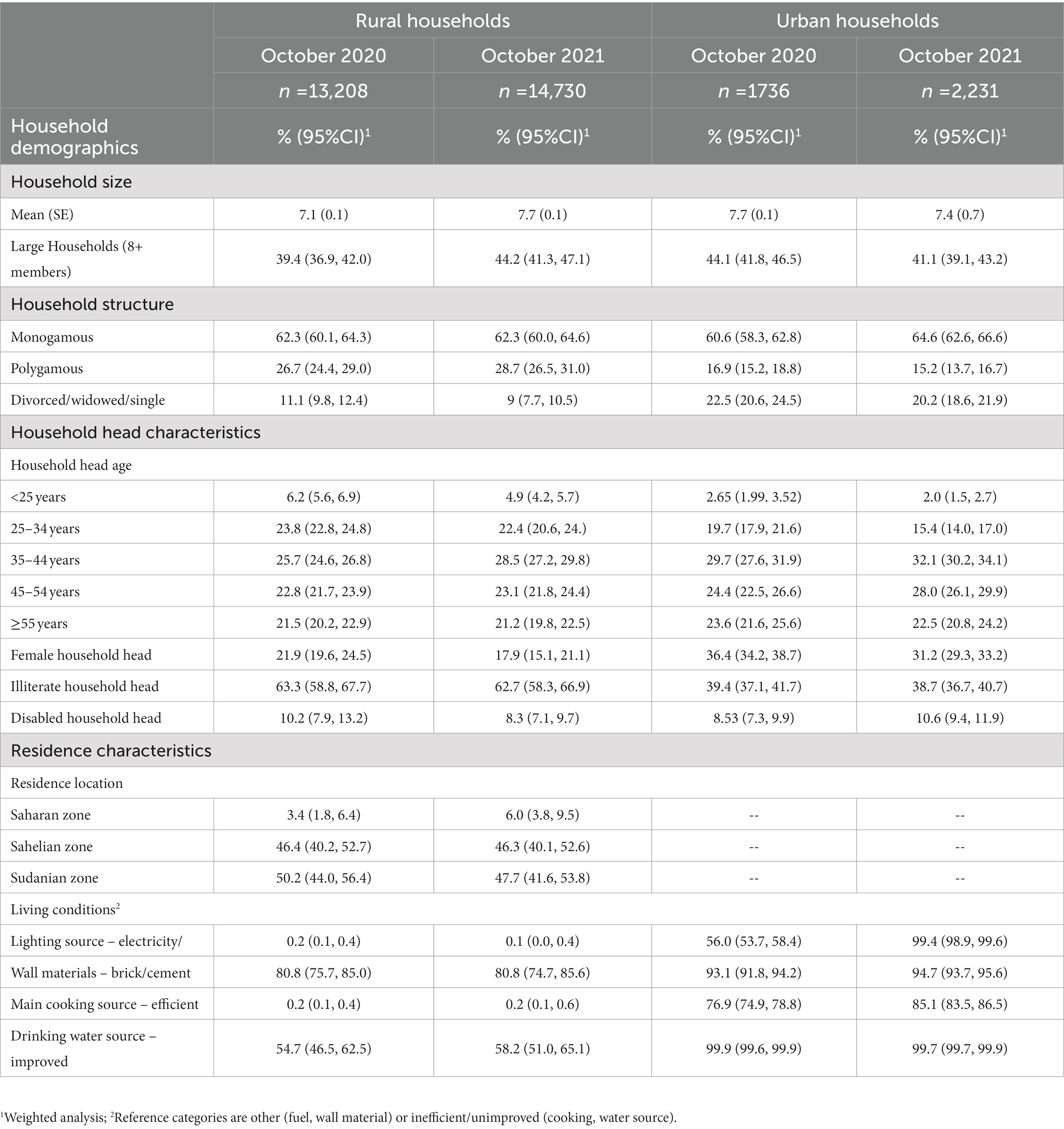
Table 1. Sociodemographic characteristics of households participating in Chad ENSA surveys, 2020–2021.
3.2. Household economy
In rural areas, the primary income sources in 2020 were agriculture (33.4%), followed by skilled/unskilled artisanal labor (23.3%), livestock rearing (22.1%), and petty trade (13.2%), and this distribution was similar in 2021. In urban areas, approximately half of the households (51.1–54.8%) reported petty trade as their primary income source, followed by skilled/unskilled/artisanal labor (12.8–18.7%) and livestock sales (15.0–17.3%) (Table 2). In urban areas, 65.9% of households experienced income loss in 2020 and this proportion reduced to 57.6% in 2021. In rural areas, 61.1% of households experienced an income reduction due to COVID-19 in 2020, and this figure increased to 66.7% in 2021. When assessed by zone, the proportion of households reporting decreased income due to COVID-19 was the largest in the Saharan zone in both 2020 and 2021. Interestingly, the proportion of households reporting COVID-19-related income reductions declined by 6.7% in the Saharan zone from 2020 to 2021 (Figures 2A,B), while increases of 4.7 and 6.7% of households reporting income loss were observed in the Sahelian and Sudanian zones, respectively. Approximately one-third of households in urban and rural areas in 2020 and in urban areas in 2021 reported a decrease in income sources (Figures 2C–F), whereas over half of rural households reported a decline in the number of income sources in 2021.
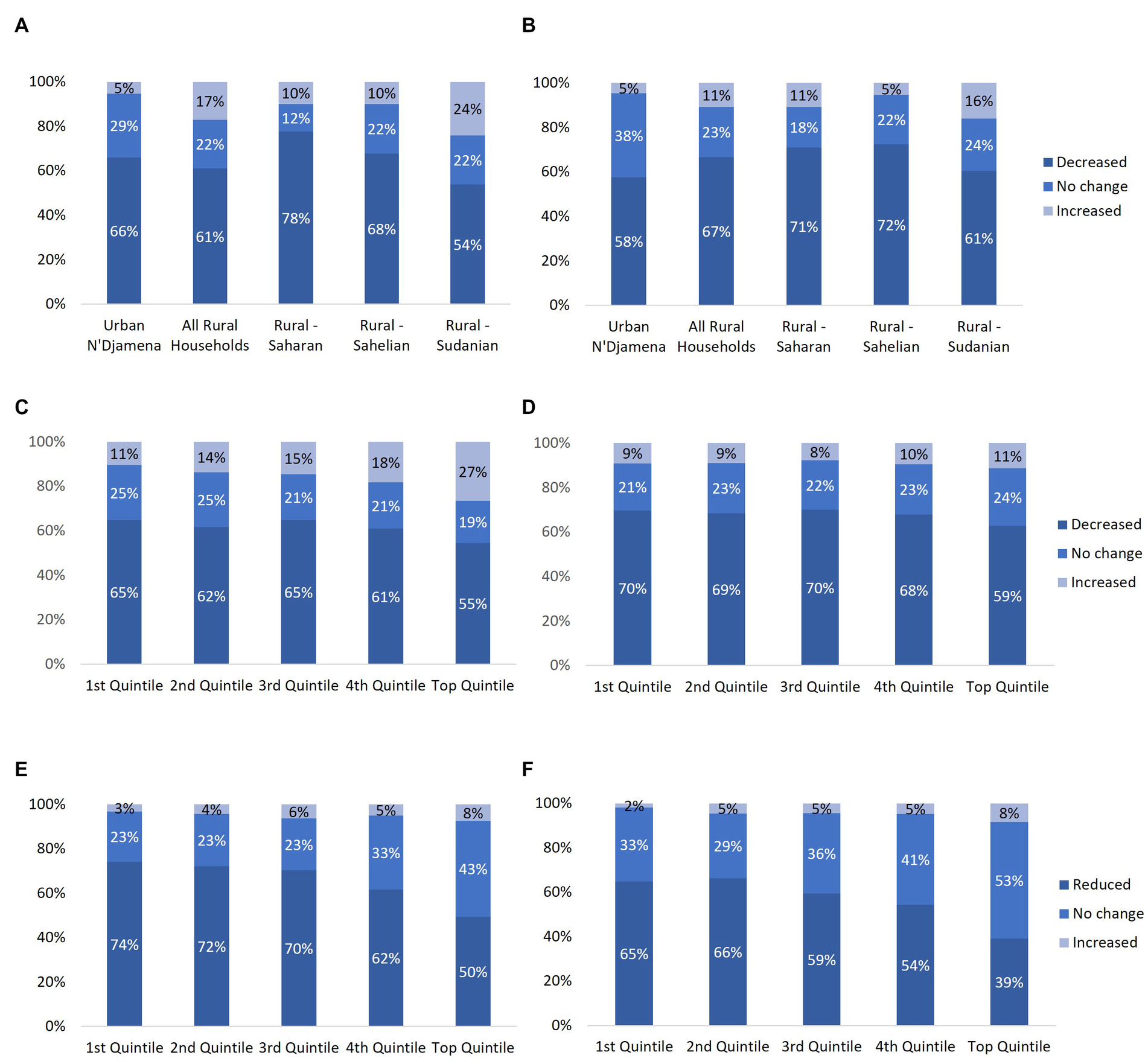
Figure 2. COVID-19 related income change by residence location and wealth quintile, 2020–2021. (A) By residence location in 2020; (B) by residence location in 2021; (C) by wealth quintile in rural 2020; (D) by wealth quintile in rural 2021; (E) by wealth quintile in N’Djamena 2020; (F) by wealth quintile in N’Djamena 2021.
Opposite trends were observed in coping mechanism use in urban and rural areas from 2020 to 2021. Coping strategy adoption was greater in urban N’Djamena households in 2020, but by 2021 a shift occurred where rural households were more likely to have adopted emergency and crisis level coping mechanism. The mean LCSI score in rural areas rose from 0.79 to 1.25 between 2020 and 2021, whereas in urban areas it declined from 0.98 to 0.59 (Table 2). In rural areas, the use of crisis-level coping mechanisms increased by 7.1% (from 11.7 to 18.8%) and emergency coping mechanism use increased by 3.5% (from 3.4 to 7.9%) from 2020 to 2021. Coping mechanism use was the greatest in the Saharan zone in both 2020 and 2021. In contrast to rural trends, urban areas saw reductions of 11.8% (from 20.2 to 8.4%) and 1.7% (from 3.2 to 1.5%) in crisis and emergency coping mechanism use, respectively. The use of coping mechanisms increased with decreasing wealth status (higher among poorer quintiles) (Figures 3A–F).
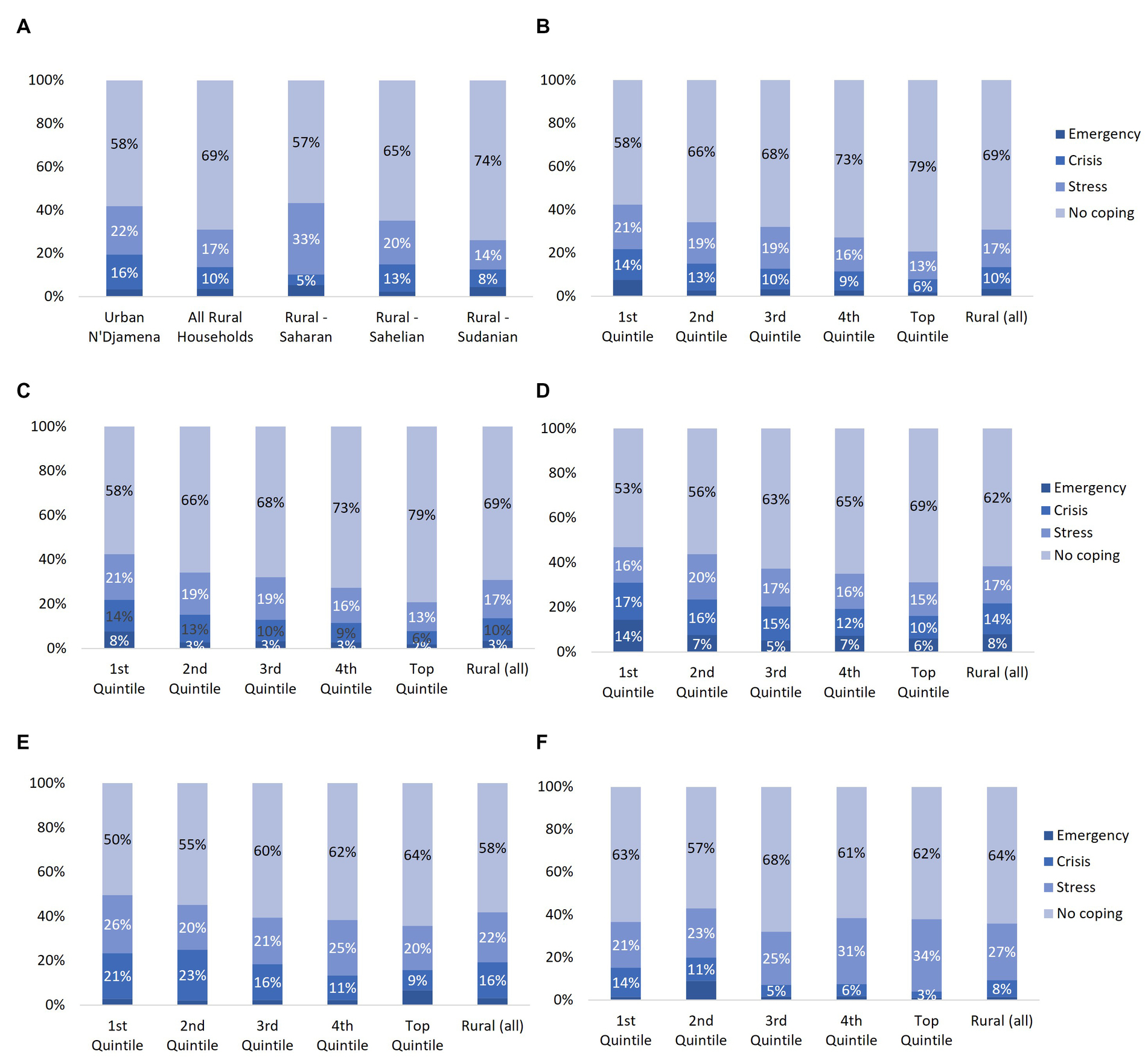
Figure 3. Livelihoods coping mechanism use by residence location and wealth quintile, 2020–2021. (A) By residence location in 2020; (B) by residence location in 2021; (C) by wealth quintile in rural 2020; (D) by wealth quintile in rural 2021; (E) by wealth quintile in N’Djamena 2020; (F) by wealth quintile in N’Djamena 2021.
3.3. Risk factors for reduced income due to COVID-19
In rural areas, adjusted models showed that male-headed households and those reporting agriculture as the primary income source were less likely to report COVID-19 related income reductions in both 2020 and 2021 (Table 3). Among rural households in 2020, female headed households were more likely to experience income loss due to COVID-19 than male headed households (OR = 1.21, CI: 1.04, 1.41) and, compared to those who reported agriculture as a primary income source, those with other primary income sources were more likely to report COVID-19 related income losses (livestock OR = 1.61, CI: 1.16, 2.24; petty trade OR = 1.47, CI: 1.09, 1.98; skilled/unskilled labor OR = 1.37, CI: 1.03, 1.81); additionally, residence in the Saharan zone was at a higher risk for income loss as compared to the Sudanian zone (OR = 2.43, CI: 1.04, 5.68). Similar to findings in 2020, a higher risk of income loss in 2021 was experienced by female headed households (OR = 1.29, CI: 1.05, 1.58) and those where livestock rearing was the primary income source (OR = 1.37, CI: 1.05, 1.80) as compared to households engaged primarily in agriculture. Unexpectedly, income loss due to COVID-19 was less likely among households having an illiterate household head in rural areas in 2021 (OR = 0.82, CI: 0.68, 1.00).
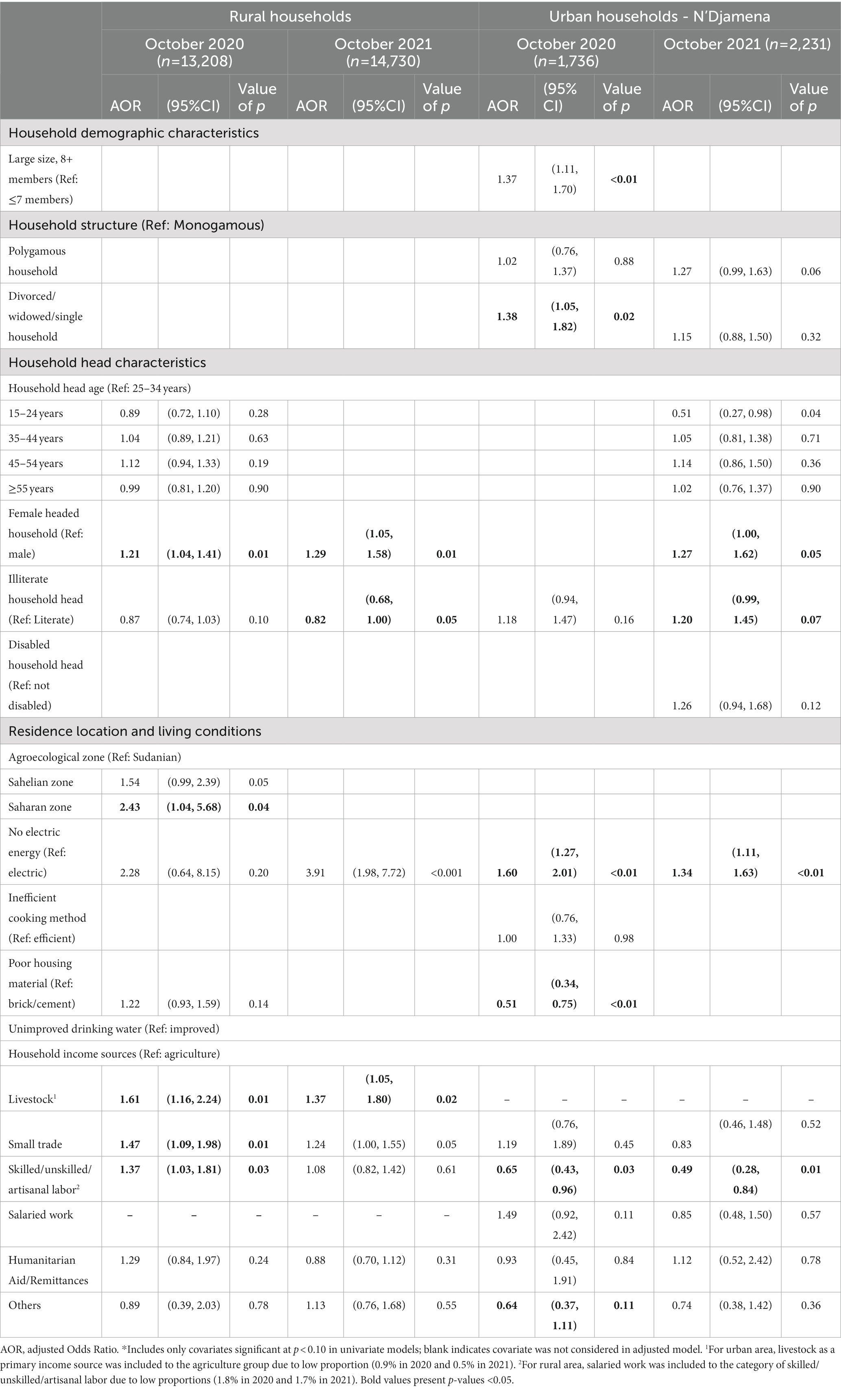
Table 3. Risk factors for reduced income due to COVID-19 in rural and urban areas of Chad, 2020–2021 (adjusted odds)*.
There was less consistency in risk factors for COVID-19 related income loss between 2020 and 2021 in urban areas. During 2020, urban households were more likely to report income loss if they had a large household size (OR = 1.38, CI: 1.05, 1.82), had an unmarried household head (OR = 1.38, CI: 1.05, 1.82; reference monogamous married households). Poor quality housing materials (OR = 0.52, CI: 0.35, 0.77) and income source as skilled/unskilled/artisanal labor (OR = 0.59, CI: 0.40, 0.88) were negatively associated with losing income, however, not using electricity as a light source (OR = 1.60, CI: 1.26, 2.02) was positively associated with income loss. In 2021, risk factors associated with income loss in urban areas included being a female headed household (OR = 1.27, CI: 1.00, 1.62) and not using electricity as a light source (OR = 1.34, CI: 1.11, 1.63), whereas engagement in skilled/unskilled/artisanal labor continued to be protective against income loss (OR = 0.49, CI: 0.28, 0.84) compared to agriculture.
3.4. Risk factors for crisis and emergency coping mechanism use
In rural areas of Chad during early COVID in 2020, having a non-agricultural primary income source (livestock rearing, [un]skilled labor, humanitarian aid, and others) was protective against the use of crisis and emergency level coping mechanisms (OR range: 0.32, 0.58) (Table 4). In contrast, female headed households (OR = 1.78, CI: 1.35, 2.35) and those with poor quality housing materials (OR = 2.10, CI: 1.36, 3.21) were more likely to adopt crisis or emergency level coping mechanisms in 2020. Later in the pandemic in 2021, the rural risk profile for coping mechanisms use changed, and both polygamous households (OR = 1.18, CI:1.00, 1.38) and unmarried household heads (OR = 1.53, CI: 1.19, 1.97) were more likely to have adopted crisis or emergency-level coping mechanisms compared to monogamous families, while female headed households had a marginally increased risk (OR = 1.20, CI: 0.99, 1.69, p = 0.05). Additionally, poor housing materials were associated with an increased risk of coping mechanism use in 2020 (OR = 2.10, CI: 1.36, 3.21). In contrast to 2020, poor quality housing was inversely associated with coping mechanism use (OR = 0.73; CI: 0.54, 0.99) in 2021.
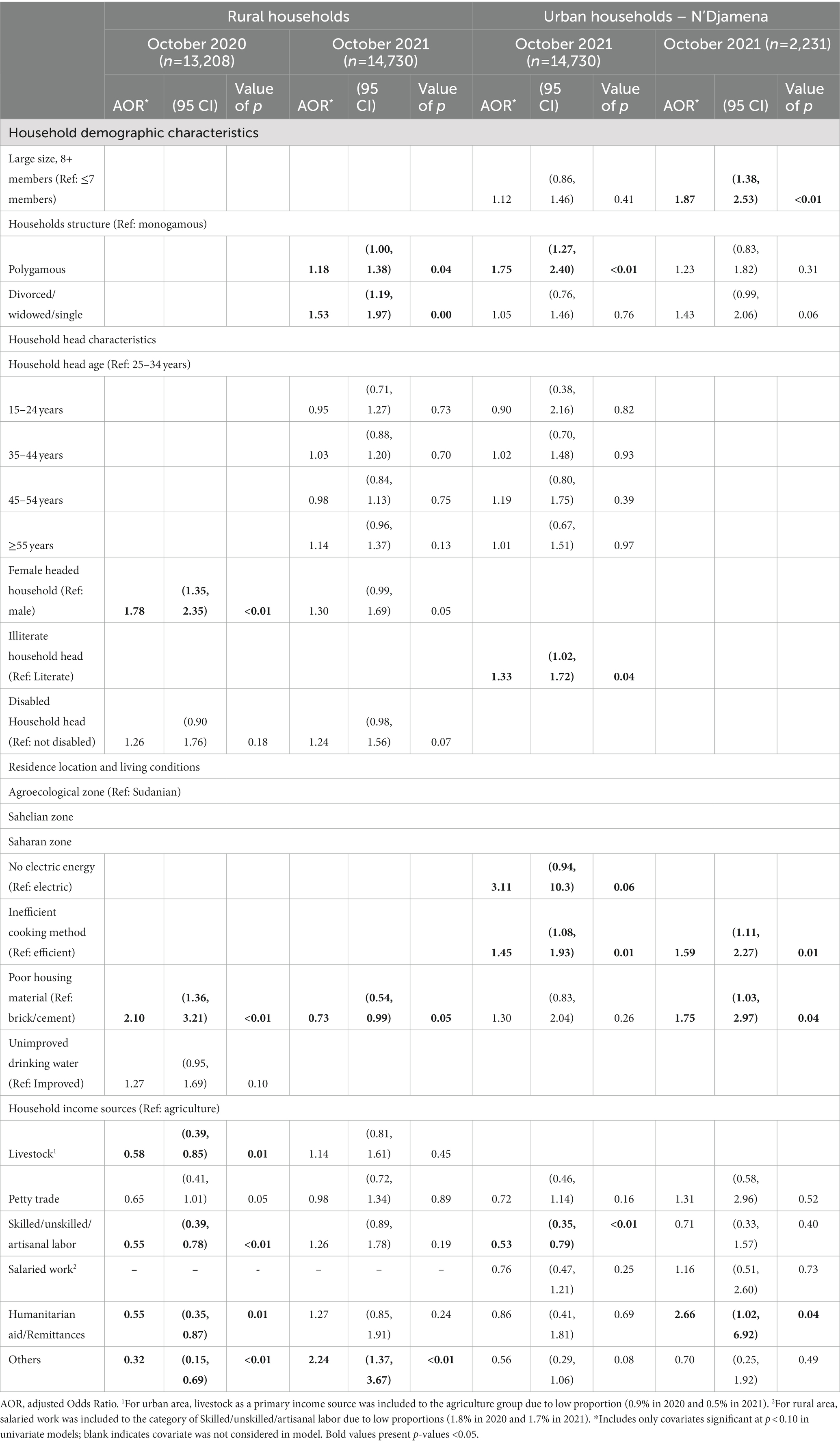
Table 4. Risk factors for crisis and emergency coping mechanism use in rural and urban areas of Chad, 2020–2021 (adjusted odds).
In urban areas during 2020, households that were more likely to adopt crisis and emergency coping mechanisms included polygamous households (OR = 1.76, CI: 1.29, 2.42), those with illiterate household heads (OR = 1.34, CI: 1.03, 1.73) and those using inefficient cooking methods (OR = 1.45, CI: 1.08, 1.93); in contrast households with skilled/unskilled labor as a primary income source were less likely than those engaged in agriculture to adopt crisis or emergency coping mechanisms (OR = 0.53, CI: 0.35, 0.79) (Table 4). In 2021, there was little consistency in risk factors for coping mechanism adoption in urban areas. Characteristics associated with increased risk of adoption of crisis or emergency level coping mechanisms included large household size (OR = 1.87, CI: 1.36, 2.53), inefficient cooking methods (OR = 1.59, CI: 1.11, 2.27), poor housing materials (OR = 1.75, CI: 1.03, 2.97), and dependency on humanitarian aid as a primary income source as compared to agriculture (OR = 2.66, CI: 1.02, 6.92).
3.5. Association between COVID-19 income reduction and coping strategy use, household expenditures, and food consumption
In rural areas, the reported income reduction due to COVID-19 was associated with the use of stress (2020 OR = 1.33, CI: 1.02, 1.72; 2021 OR = 1.56, CI: 1.22, 1.99) and crisis (2020 OR = 1.60, CI: 1.11, 2.32; 2021 OR = 1.55, CI: 1.23, 1.96) but not emergency level coping mechanisms (Table 5). In 2020, rural households reporting COVID-19 income reduction were more likely to have poor food consumption than those that did not experience income reduction (OR = 1.35, CI: 1.00, 1.82) and COVID-19 income reduction was associated with lower short-term expenses (all p = 0.047) and long-term expenses (all p < 0.01) in both 2020 and 2021. A largely similar trend was observed in urban N’Djamena where households that reported COVID-19 income reductions were likely to use stress (2020 OR = 1.90, CI: 1.52, 2.38) and crisis (2020 OR = 1.46, CI: 1.10, 1.95; 2021 OR = 2.54, CI: 1.77, 3.66) coping mechanisms (emergency level coping mechanism were not examined due to small sample size). In 2020, households reporting income reduction had significantly lower short-term (p < 0.01), long-term (p < 0.01) and the proportion of foods expenditure (beta = 2.1%; p = 0.01) compared to households without income reduction; this association was not examined in 2021 due small sample size.
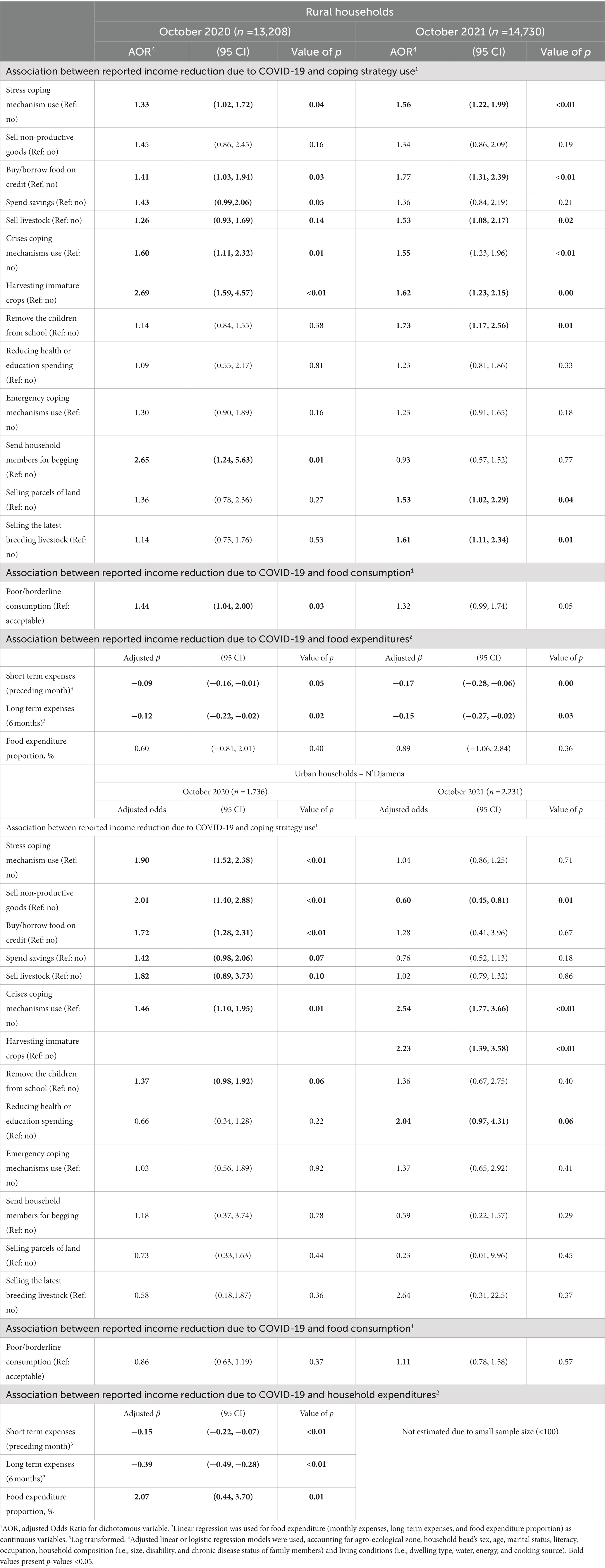
Table 5. Association between COVID-19 income reduction and coping strategy use, food consumption and food expenditure.
4. Discussion
Using 2 years of national ENSA survey data from Chad in 2020 and 2021, this study sought to characterize trends in household food security at the onset of the COVID-19 pandemic. Specifically, the analysis explored the risk factors for reported income loss due to COVID-19 and the use of crisis and emergency coping mechanisms and explored relationships between income loss, coping strategy use, food consumption, and household expenditures. In 2020, the reported income reduction was higher in urban areas than rural areas (65.9% vs. 61.1%) and in 2021, the trend in the income reduction was the opposite with a decrease in N’Djamena (to 57.6%) but an increase in rural areas (66.7%). Coping mechanism adoption trends were consistent with observed income reductions.
Among rural households, those headed by females, living in the Saharan zone, and engaged in livestock rearing, petty trade, or skilled/unskilled labor were at higher risk of income loss. In urban areas, households that were large and headed by individuals that were unmarried, female and/or illiterate were more likely to report income losses. However, the skilled/unskilled labor occupation was protective against income loss compared to those engaged in agriculture/livestock rearing in urban areas. There were many shared risk factors between coping mechanism adoption and COVID-19 related income reduction. Polygamous households, those with unmarried and female household heads, and households with agriculture as a main income source were at higher risk of adopting coping strategies in rural areas. In N’Djamena, polygamous families, those with illiterate household heads, and with poor living conditions were more likely to adopt severe coping mechanisms. Households that experienced COVID-19 income loss were more likely to use coping strategies, have lower short (preceding month)- and long-term (6 months) household expenses, and have poor or borderline food consumption, as compared to those with increased income or no change in income status.
4.1. Trends in COVID-19 related income reduction and use of livelihoods coping mechanism use
Two-thirds of households in both rural and urban areas reported COVID-19 income reductions, with greater reductions in urban areas in 2020 and rural areas in 2021. This finding is consistent with a multi-country study in Sub-Saharan Africa on COVID-19 impact that also reported two-thirds of households had COVID-19 related income losses with loss of family enterprise revenue and lost jobs being the most frequent causes (Dasgupta and Robinson, 2021). This is likely due to earlier and stricter enforcement of COVID-19 prevention measures in N’Djamena compared to rural areas. This observation in Chad reflects the global trend in the economic recessions in urban areas during 2020. A study on 2020 lockdowns in eight Asia pacific countries reported similar results, with a higher proportion of urban residents reporting a loss of jobs and reduced income since COVID-19 as compared to rural populations (Kang et al., 2021). It is not surprising that households with food production capacity would be more protected from the impacts of rising food prices, and COVID-19 related economic losses (FAO, 2020). Nevertheless, the prolonged nature of the pandemic and associated restrictions resulted in a progressive strain on livelihoods and a corresponding increase in the use of coping mechanisms between 2020 and 2021.
4.2. Risk factors for income loss and coping mechanism adoption
The identified risk factors for income loss and coping mechanisms adoption are related to socio-economically disadvantaged groups, including households with female-headed, illiterate, and unmarried heads. Households with these characteristics were already more likely to be economically disadvantaged—for example in rural households, 38% of the lowest wealth quintile were female headed households compared to 8% in the richest quintile and 83% of widowed/divorced/single headed households were female headed. Single earner households and those with higher dependency ratios may be economically more vulnerable, and the patriarchal nature of society renders women and female headed households more vulnerable to economic losses due to more limited access to a broad spectrum of resources and opportunities.
In our study, the negative association between literacy and the economic impact could be linked to the fact that the main income source for illiterate household heads is subsistence agriculture, who were less likely to report income reductions due to COVID-19 as they retained access to their gardens/farms located close to the household. In this study, coping strategy index scores were the highest in urban areas in 2020. Studies that assessed determinants of coping mechanism adoption during COVID-19 lockdowns in other settings reported similar findings, with higher rates of coping mechanism use among urban residents and lower wealth groups during the early stages of the pandemic (Das et al., 2020). The high reduction in income due to COVID-19 and the subsequent increase in the use of emergency coping mechanisms is thus likely directly linked to the enforcement of COVID-19 prevention measures such as the prolonged border and market closures.
4.3. Geographic variations of rural food insecurity
When considering the three agro-ecological regions of Chad, households in the Sudanian zone were wealthier, with ~32% of the richest quintile residing in the area, and agriculture was a more common income source, which likely contributed to households having more food stocks and/or agriculture-based income sources that suffered fewer COVID-19 related disruptions. The Saharan zone, which accounts for only ~6% of the rural population, was less wealthy, with more than half of households in the lowest quintile, and the population engaged primarily in livestock rearing (30%) and (un)skilled paid labor or salaried jobs (28%), both of which posed a greater risk of COVID-19 economic losses as compared to agriculture. In Chad, cross-border livestock trade is a major way transhumant and agro-pastoral households earn a living in the Saharan zone, mediated through weekly livestock markets in a complex relationship between ethnic groupings of herders, traders and other intermediaries (Koussou, 2002). Lockdowns and movement restrictions resulted in disruptions of livestock production and supply chains, declines in livestock sales due to market closure, causing the pastoralists to lose income (Griffith et al., 2021). In adjusted models that account for these factors, households in the Saharan zone were twice (AOR = 2.03, CI: 1.04, 5.68) as likely as those in the Sudanian zone to report COVID-19 income loses in 2020, but they were not at increased risk for income loss in 2021 or coping strategy adoption in either year. The population in the Sahelian zone followed the same pattern of increased risk for COVID-19 related income loss in 2020 only (AOR = 1.54, CI: 0.99, 2.39) and had similar coping mechanism use. One potential contributing factor for income losses in the Sahel was the poor rainy seasons leading into the pandemic which led to fodder deficits among pastoralists (ECOWAS – SWAC/OECD initiative, 2008; World Bank, 2020).
4.4. The COVID-19 response
Social safety net programs were rolled out rapidly in Chad in response to the pandemic, with about 20% of households receiving at least one government transfer; additionally, 437,000 food kits were distributed to vulnerable households and agricultural inputs (seeds, equipment) were provided to smallholder farmers (World Bank, 2022b). Cash safety net programs have become an effective strategy (Makkar et al., 2022), as compared to in-kind food provision, to reduce food insecurity and in Chad, cash transfers have shown to be effective among vulnerable groups such as female headed households and those with low educational attainment and incomes (Dasgupta and Robinson, 2022). While cash transfers can be rapidly scalable, one notable disadvantage in their application by governments in the early COVID-19 response was the risk of excluding the most vulnerable groups, such as informal workers and those without access to social insurance. Temporary assistance and humanitarian relief programming, which were intended to address this gap, were slower to be established and faced both corruption and targeting challenges (Devereux et al., 2020). Social safety net programs do appear to have reduced extreme food insecurity (the probability of going without food for a whole day) in Chad (Dasgupta and Robinson, 2021). In November 2021, WFP’s impact monitoring of its COVID-19 response in the provinces of Logone Occidental and Logone Oriental showed that the proportion of households reporting acceptable food consumption increased from 43 to 70% while the use of crisis or emergency coping strategies reduced from 26 to 16% among those assisted (Unpublished).
4.5. Implications for future responses
Findings of this study suggest that targeting female and unmarried household heads, and in the case of economic shocks, urban households may be most impactful. Notable regional differences in rural food security could also inform targeting strategies at the national level. However, while this is in line with the common understanding of vulnerability and targeting, the study also reveals some counter-intuitive aspects that future responses may need to consider. Dependence on agriculture and illiteracy of the household head are not necessarily synonymous with high vulnerability. Thus, the targeting of responses needs to be tailored to the evolution of the shock in question and how this affects different sub-groups of the population. Furthermore, the study reveals a differential impact of households dependent on skilled/unskilled/artisanal labor which was a risk factor to income loss in the rural setting but a protective factor in the urban setting. This suggests the need for a local, systemic understanding of household economic activities and how these are affected by the evolution of the shock. Alarcon et al. (2021) emphasize the need for a food systems approach in the context of health emergencies and caution on common failures such as the lack of differentiation of people working in the food systems and how they are organized among others (Alarcon, Dominguez-Salas, Fèvre, & Rushton, 2021).
4.6. Limitations
This analysis leveraged nationally representative datasets with relatively large sample sizes to characterize the economic impact of COVID-19 between 2020 and 2021 in both rural and urban areas. Due to the nature of secondary analysis of existing survey data, the study had several critical limitations. First, rural and urban surveys were conducted independently, though at similar time points in the year, with different sampling frames necessitating separate analyses. The surveys applied the same population-based sampling methodology in each year, however, samples were independent and change over time in specific households could not be examined. Second, the primary outcome—COVID-19 income reduction—is self-reported by the respondent, and subject to both recall and reporting bias. A third limitation is that the ENSA data set did not include income amounts, but rather asked how income had changed due to COVID-19 (i.e., a categorical variable) which limited the depth of analysis possible, where quantifying income losses would have been preferable. While the question focused on COVID-19 income-related losses, the survey did not specifically query for other factors that may have contributed to income reductions such as poor rainfall which affected crop production and harvest in some areas of the country in 2020. A final limitation is that the study was unable to characterize the impact of the social safety net and humanitarian response on COVID-19 impacts.
5. Conclusion
The COVID-19 pandemic caused a significant increase in household food insecurity in both rural and urban areas in Chad. Two-thirds of households lost income due to COVID-19 in 2020 and 2021; during early COVID in 2020, a larger proportion of urban households reported income loss, whereas later in 2021, a larger proportion of rural households reported COVID-19 related income reductions. In 2020, higher levels of income loss in N’Djamena were accompanied by higher adoption rates of emergency and crisis level coping mechanisms. However, as the pandemic progressed, impacts on urban households subsided while an opposite trend was observed for rural households which saw greater income losses and coping mechanism adoption. Rural households in the Saharan zone were most likely to report COVID-19 related income losses and had the highest rates of coping mechanism use in both 2020 and 2021. Socio-economically disadvantaged groups, including those with less wealth and households headed by females, illiterate and unmarried heads had increased risk of income loss and coping mechanism adoption, which is consistent with findings from other studies in the region.
This study elucidates the potential impact pathways of COVID-19 from a household economic downturn to limited food spending, poor food consumption, and increased use of short-term coping mechanisms. While large-scale lockdowns seen in the early COVID-19 response are unlikely to reoccur, the differential impact of these measures on urban and rural populations and by household income source was notable. In the case of the COVID-19 pandemic lockdowns, it is apparent that vulnerable households in both rural and urban areas of Chad were more likely to be impacted, however, the difference between wealth quintiles was modest, with larger variations seen by geographic location. This observation suggests that responses to future economic shocks should incorporate an in-depth regional analysis to inform more refined targeting strategies. Given that larger households, those with poor living conditions, and those with unmarried, female or illiterate household heads faced increased risk for income loss and emergency or crisis-level coping mechanism adoption and that these are often criteria for targeting assistance, results from this study suggest that typical beneficiary selection strategies were likely to be appropriate in the COVID-19 response.
The variation in impact on households according to livelihood groups and rural and urban settings suggests the need for proactive, local food-systems based solutions, that address vulnerabilities of specific sub-groups but also reinforce livelihood opportunities and increase resilience. One notable challenge when considering responses to large scale economic shocks going forward is the coordination of social safety net programs and humanitarian response, and perhaps importantly, the provision of rapid assistance to these groups, which may not be included in more rapidly scalable social safety net programs.
Data availability statement
The data analyzed in this study is subject to the following licenses/restrictions: the data that support the findings of this study are available from World Food Programme Chad. Data are available with the permission of World Food Programme Chad. Requests to access these datasets should be directed to edgar.wabyona@wfp.org.
Ethics statement
Ethical review and approval was not required for the study on human participants in accordance with the local legislation and institutional requirements. Written informed consent from the participants was not required to participate in this study in accordance with the national legislation and the institutional requirements.
Author contributions
YK, EW, and SD contributed to conception and design of the study. EW organized the database. YK performed the statistical analysis. YK and SD wrote the first draft of the manuscript. EW, FU, and AT wrote sections of the manuscript. All authors contributed to manuscript revision, read, and approved the submitted version.
Funding
This study was funded by World Food Programme Chad.
Conflict of interest
The authors declare that the research was conducted in the absence of any commercial or financial relationships that could be construed as a potential conflict of interest.
Publisher’s note
All claims expressed in this article are solely those of the authors and do not necessarily represent those of their affiliated organizations, or those of the publisher, the editors and the reviewers. Any product that may be evaluated in this article, or claim that may be made by its manufacturer, is not guaranteed or endorsed by the publisher.
References
Alarcon, P., Dominguez-Salas, P., Fèvre, E. M., and Rushton, J. (2021). The importance of a food systems approach to low and middle income countries and emerging economies: a review of theories and its relevance for disease control and malnutrition. Front. Sustain. Food Syst. 5:642635. doi: 10.3389/fsufs.2021.642635
Arndt, C., Davies, R., Gabriel, S., Harris, L., Makrelov, K., Robinson, S., et al. (2020). COVID-19 lockdowns, income distribution, and food security: an analysis for South Africa. Glob. Food Sec. 26:100410. doi: 10.1016/j.gfs.2020.100410
Béné, C., Bakker, D., Rodriguez, M. C., Even, B., Melo, J., and Sonneveld, A. (2021). Impacts of COVID-19 on people’s food security: Foundations for a more resilient food system. Executive summary. Executive Summary February 2021. CGIAR COVID-19 Hub. doi: 10.2499/p15738coll2.134298
Buheji, M., da Costa Cunha, K., Beka, G., and Mavrić, B. (2020). The extent of COVID-19 pandemic socio-economic impact on global poverty. A global integrative multidisciplinary review. Am. J. Econ. 10, 213–224. doi: 10.5923/j.economics.20201004.02
Burström, B., and Tao, W. (2020). Social determinants of health and inequalities in COVID-19. Eur. J. Pub. Health 30, 617–618. doi: 10.1093/eurpub/ckaa095
Chirisa, I., Mutambisi, T., Chivenge, M., Mabaso, E., Matamanda, A. R., and Ncube, R. (2022). The urban penalty of COVID-19 lockdowns across the globe: manifestations and lessons for anglophone sub-Saharan Africa. GeoJournal 87, 815–828. doi: 10.1007/s10708-020-10281-6
Das, S., Rasul, M. G., Hossain, M. S., Khan, A. R., Alam, M. A., Ahmed, T., et al. (2020). Acute food insecurity and short-term coping strategies of urban and rural households of Bangladesh during the lockdown period of COVID-19 pandemic of 2020: report of a cross-sectional survey. BMJ Open 10:e043365. doi: 10.1136/bmjopen-2020-043365
Dasgupta, S., and Robinson, E. J. Z. (2021). Food insecurity, safety nets, and coping strategies during the COVID-19 pandemic: multi-country evidence from sub-Saharan Africa. Int. J. Environ. Res. Public Health 18:9997. doi: 10.3390/ijerph18199997
Dasgupta, S., and Robinson, E. J. Z. (2022). Impact of COVID-19 on food insecurity using multiple waves of high frequency household surveys. Sci. Rep. 12:1865. doi: 10.1038/s41598-022-05664-3
Devereux, S., Béné, C., and Hoddinott, J. (2020). Conceptualising COVID-19's impacts on household food security. Food Secur 12, 769–772. doi: 10.1007/s12571-020-01085-0
ECOWAS – SWAC/OECD initiative. (2008). Livestock and regional market in the Sahel and West Africa potentials and challenges. Paris:Sahel and West Africa Club/OECD.
FAO. (2020). Revised humanitarian response (may–December 2020): Coronavirus disease 2019 (COVID-19); technical report. FAO: Rome, Italy.
FAO, IFAD, UNICEF, WFP, and WHO. (2022). The state of food security and nutrition in the world 2022: repurposing food and agricultural policies to make healthy diets more affordable.
Griffith, E., Craige, S., Manzano, P., Pius, L., and Jost, C. (2021). Chapter eight - impacts of the COVID-19 pandemic on food security among east and west African pastoralists. Adv Food Secur Sustain 6, 231–261. doi: 10.1016/bs.af2s.2021.07.004
International Labor Organization (2021). ILO monitor: COVID-19 and the world of work. Seventh edition updated estimates and analysis. Geneva, Switzerland:International Labor Organization.
Kang, Y., Baidya, A., Aaron, A., Wang, J., Chan, C., and Wetzler, E. (2021). Differences in the early impact of COVID-19 on food security and livelihoods in rural and urban areas in the Asia Pacific region. Glob. Food Sec. 31:100580. doi: 10.1016/j.gfs.2021.100580
Koussou, M. (2002). Diagnostic et propositions en vue de moderniser le commerce et la transformation des produits de l'elevage au TCHAD: rapport de mission d'appui au PASEP. République du Tchad Ministère de l'élevage Direction -générale Coordination du PASEP. Yaoundé: Ministère de l’Elevage, 61 p.
Macharia, P. M., Joseph, N. K., Sartorius, B., Snow, R. W., and Okiro, E. A. (2021). Subnational estimates of factors associated with under-five mortality in Kenya: a spatio-temporal analysis, 1993-2014. BMJ Glob. Health 6:e004544. doi: 10.1136/bmjgh-2020-004544
Makkar, S., Manivannan, J. R., Swaminathan, S., Travasso, S. M., John, A. T., Webb, P., et al. (2022). Role of cash transfers in mitigating food insecurity in India during the COVID-19 pandemic: a longitudinal study in the Bihar state. BMJ Open 12:e060624. doi: 10.1136/bmjopen-2021-060624
Mennechet, F. J. D., and Dzomo, G. R. T. (2020). Coping with COVID-19 in sub-Saharan Africa: what might the future hold? Virol. Sin. 35, 875–884. doi: 10.1007/s12250-020-00279-2
Negesse, A., Woyraw, W., Temesgen, H., Teka, Y., Yismaw, L., Akalu, T. Y., et al. (2022). Spatial exploration of non-resilience to food insecurity, its association with COVID-19 and household coping strategies in east Gojjam districts, Northwest Ethiopia, 2020. Sci. Rep. 12:15511. doi: 10.1038/s41598-022-19963-2
Padmaja, R., Nedumaran, S., Jyosthnaa, P., Kavitha, K., Abu Hatab, A., and Lagerkvist, C. J. (2022). COVID-19 impact on household food security in urban and peri-urban areas of Hyderabad. India Front Public Health 10:814112. doi: 10.3389/fpubh.2022.814112
Patel, V., Chisholm, D., Dua, T., Laxminarayan, R., and Medina-Mora, M. E. (2015). Mental, neurological, and substance use disorders: disease control priorities, third edition (volume 4). Washington, DC: World Bank.
Shahidul, M., and Mostafa, I. (2021). Coping strategies of low-income households in Bangladesh during the COVID-19 pandemic. J Bangladesh Stud 23, 56–78.
Système d’Information sur la Sécurité Alimentaire et d’Alerte Précoce du TCHAD (2020). Enquête nationale de sécurité alimentaire (ENSA) 2020. Tchad. (Données collectées en février–mars 2021). Available at: https://sisaaptchad.org/wp-content/uploads/2021/09/Rapport-ENSA-fevrier-2021-vf.pdf
Système d’Information sur la Sécurité Alimentaire et d’Alerte Précoce du TCHAD (2022). Enquête Nationale de Sécurité Alimentaire au TCHAD (ENSA) RAPPORT (Données collectées en février 2022). N’Djaména, SISAAP.
Tchana Tchana, F., Kassim, O., Savadogo, A., Ouedraogo, A., and Coulibaly, M. (2022). Chad economic and poverty update under COVID-19, spring 2020 World Bank, Washington, DC:
WFP VAM resource center. (2021). Livelihood Coping Strategies – Food Security. WFP, Rome. Available at: https://resources.vam.wfp.org/data-analysis/quantitative/food-security/livelihood-coping-strategies-food-security
WHO. (2023). WHO Health Emergency Dashboard. WHO (COVID-19) Homepage. Available at: https://covid19.who.int/region/afro/country/td
Wiesmann, D., Bassett, L., Benson, T., and Hoddinott, J. (2009). Validation of the world food programme’s food consumption score and alternative indicators of household food security. Washington, DC: INTERNATIONAL FOOD POLICY RESEARCH INSTITUTE.
Workie, E., Mackolil, J., Nyika, J., and Ramadas, S. (2020). Deciphering the impact of COVID-19 pandemic on food security, agriculture, and livelihoods: a review of the evidence from developing countries. Curr Res Environ Sustain 2:100014. doi: 10.1016/j.crsust.2020.100014
World Bank. (2020). Where climate change is reality: Supporting Africa’s Sahel pastoralists to secure a resilient future. Washington, DC:World Bank. Available at: worldbank.org.
Keywords: COVID-19, Chad, income, household economy, food security, coping mechanism
Citation: Kang Y, Wabyona E, Udahemuka FR, Traore A and Doocy S (2023) Economic impact of COVID-19 on income and use of livelihoods related coping mechanisms in Chad. Front. Sustain. Food Syst. 7:1150242. doi: 10.3389/fsufs.2023.1150242
Edited by:
Rupak Goswami, Ramakrishna Mission Vivekananda Educational and Research Institute, IndiaReviewed by:
Vengadeshvaran Sarma, Nottingham University Business School, MalaysiaShinoj Parappurathu, Central Marine Fisheries Research Institute (ICAR), India
Copyright © 2023 Kang, Wabyona, Udahemuka, Traore and Doocy. This is an open-access article distributed under the terms of the Creative Commons Attribution License (CC BY). The use, distribution or reproduction in other forums is permitted, provided the original author(s) and the copyright owner(s) are credited and that the original publication in this journal is cited, in accordance with accepted academic practice. No use, distribution or reproduction is permitted which does not comply with these terms.
*Correspondence: Yunhee Kang, eWthbmcxMkBqaHUuZWR1
 Yunhee Kang
Yunhee Kang Edgar Wabyona2
Edgar Wabyona2 Francois Regis Udahemuka
Francois Regis Udahemuka